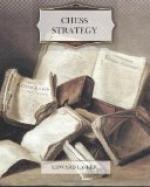How to conduct the middle game and end-game is not entirely a matter of deduction from such general rules. In order to play the end-game correctly, one must know certain things and positions which arise from and may be said to be peculiar to the purely arbitrary rules of chess. The same applies to the middle game, as in most cases it must be played with a view to the end-game which ensues, unless there be a chance of mating the opponent before. The student should have, therefore, a knowledge of the end-game before he can hope to be able to conduct the middle game efficiently. For this reason I have decided to treat of the end-game first.
CHAPTER V
THE END-GAME
Just as it is difficult to state the exact point at which an opening ends, so is it equally difficult to say where the end-game may be said to commence. One of the main characteristics of end-games is the active part taken by the King. Clearly the King cannot venture out into the field of operations until there has been an exchange of the majority of the pieces, so that there can be no danger of his being mated. As soon as a player has attained some advantage in material which ensures the victory in the end-game, he will try to bring about the end-game by exchanging pieces, for there the lines on which to push home his advantage are clearly set out.
It is first necessary to know what surplus of forces is the minimum required in order to force a mate. The positions in which the mate can be forced may be shown by a few typical examples. But I shall lay stress mainly on one point. That is the ability to judge whether an end-game which could be brought about by exchanges is won or not; in other words, whether it can be reduced to one of the typical positions referred to above.
It is obvious that the end-game is the particular demesne of pawn strategy. Nearly always one or more pawns survive the exchange of pieces, and the knowledge of the end-game will be invaluable for gauging the consequences of pawn moves in the course of the middle game. The latter represents probably the most difficult aspect of the strategy of chess.
In order to enable beginners to grasp the following chapters, I must again point out a few elementary considerations.




